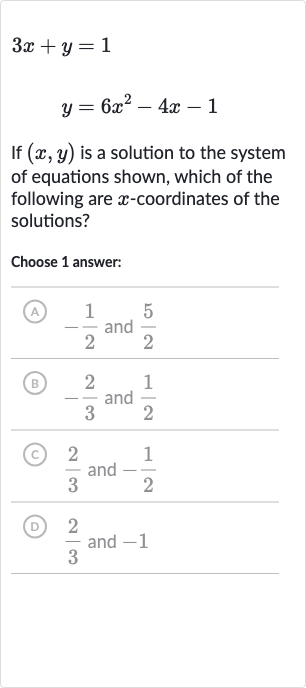AI tutor
Welcome to Bytelearn!
Let’s check out your problem:

If is a solution to the system of equations shown, which of the following are x-coordinates of the solutions?Choose answer:(A) and (B) and (C) and (D) and }
Full solution
Q. If is a solution to the system of equations shown, which of the following are x-coordinates of the solutions?Choose answer:(A) and (B) and (C) and (D) and }
- Equations Given: We have a system of two equations:. . To solve the system, we can substitute the expression for from the second equation into the first equation. This will give us an equation with only one variable, , which we can then solve.
- Substitute into first equation: Substitute into the first equation:
- Combine and simplify: Combine like terms and simplify the equation:
- Quadratic equation: Subtract from both sides to set the equation to zero:
- Factor the quadratic: Now we have a quadratic equation. We can solve for by factoring, completing the square, or using the quadratic formula. The equation looks like it might be factorable, so let's try factoring first.
- Set factors to zero: We look for two numbers that multiply to and add up to . These numbers are and . So we can write the equation as:
- Solve for x: Set each factor equal to zero and solve for x: or
- Final x-coordinates: Solve the first equation for x:
- Final x-coordinates: Solve the first equation for x:Solve the second equation for x:
- Final x-coordinates: Solve the first equation for x:Solve the second equation for x:We have found two x-coordinates where the system of equations has solutions: and . These correspond to answer choice (B).
More problems from Write two-variable inequalities: word problems
QuestionGet tutor help
QuestionGet tutor help
QuestionGet tutor help
QuestionGet tutor help
QuestionGet tutor help
QuestionGet tutor help
QuestionGet tutor help
QuestionGet tutor help
